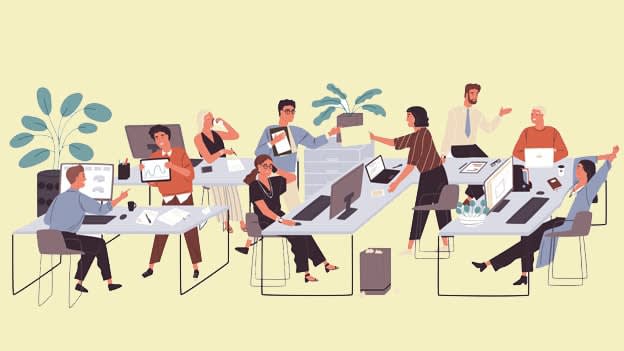Using OXYTOCIN for fostering trust in an organization

‘What will be the future of work?’ - it has been some years since that question was first asked. It is also difficult to underline the moment of origin of this question and the thought that triggered it - was it the emergence of the digital organization, contractual workers becoming the foundation of global businesses or the first time artificial intelligence was used to give purchase recommendations to users? Whatever it was, it did start a timeless discussion about the future organization - paving way for both a utopian and dystopian view.
All this talk raised a follow-up question - “What will be the future of HR?” This too led to arguments to the extreme - on the lines of ‘HR could become redundant’ and ‘Future organizations will not have an HR department’.
This article is not meant to start this debate. As a matter of fact, this article argues that no matter how the future workplace operates, the core responsibility of the Human Resources function would still be to get the best out of its talent and drive the business forward.
Where should the (present and) future HR focus on?
In the age of uncertainty, it is worthwhile to fall back on science and seek answers for the aforementioned question. Decades of research in neuroscience has found the critical role played by a culture of trust in business performance. Paul Zak conducted a research, “Trust and Growth” to establish a correlation between trust and business performance. His work had two critical findings:
The higher the trust within an organization, the better the business performance would be
The human brain releases the oxytocin hormone when it feels it is being trusted. This oxytocin leads the human brain to reciprocate that trust
Creating this culture of trust can not only enable a psychologically safe environment where people have faith in each other, but also lead to a successful business.
What is OXYTOCIN and how can HR leverage it in building a culture of trust?
Paul Zak devised the eight components of organizational trust after his research. He abbreviated them using the term OXYTOCIN (after being inspired from the trust-inducing hormone he had discovered in his research).
Here is what OXYTOCIN stands for and how it can be used as a building block of creating that culture in the organization
Ovation
Recognizing great work has a positive impact on building trust in an organization. According to neuroscience, recognition is the most effective when:
- It happens immediately after a goal is achieved
- It comes from peers
- It is personal and happens in public
The role of HR then becomes to create structured systems of recognition within their organization, and create the culture of recognizing and rewarding great work.
Expectation
Clear expectation and goal-setting has also been found to induce a culture of trust. In his research, Zak found that if a difficult but achievable goal is assigned and the tasks associated with it cause moderate stress, it leads to the release of oxytocin and adrenocorticotropin. These neurochemicals intensify people’s focus. However, Zak notes that this can only work if the challenges are achievable with a clear end point.
HR’s role, to achieve this, is in establishing performance management processes which enable this clear goal-setting and mechanisms for employees to work in groups and have open channels for check-ins and feedback.
Yield
Give up control, delegate responsibilities, and let people work on projects independently. Allow them the freedom to make decisions, and execute the project in their own way. Allowing people to do things their own way is a huge symbol of trust, and based on Zak’s research, people can be expected to reciprocate that trust in you.
HR’s role is crucial in designing the organization in a way that there is space for projects to be driven independently without micro-management from superiors, and creating an environment which rewards this behavior.
Transfer
Trust in people to craft their own jobs - to take control of their careers and move to different, challenging projects. This makes them feel they are trusted and are likely to replicate this for the organization as a collective.
Openness
This implies being honest and open about sharing information. Information could be about business performance, company’s goals and objectives, or the organization’s renewed vision. Trusting employees with critical information fosters a trustworthy culture.
For HR to facilitate this, they can help in channelizing these pieces of information in a structured way through townhalls, email communication, or internal social channels.
Caring
Social relations between people in an organization can also lead to an increase in trust, and in turn improve business performance. Another neuroscience experiment by Paul Zak found that when people intentionally build social ties at work, their performance improves.
For HR, the responsibility is to enable engagement among individuals and give them a platform to initiate dialogue and meet each other.
Invest
Be truly invested in the growth of the organization’s employees. This has also been found to foster trust. The development extends to personal as well - high-trust organizations enable their people to grow as a human being. A growth mindset is adopted when developing talent.
HR’s responsibility in enabling this development is to champion the learning function. Make their current employees ready for the next role - which may as well be outside their current organization. This trust and investment in the people’s development will be reciprocated to the organization as well.
Natural
Research has found that leaders’ seeking help from their colleagues in a workplace generates trust. This can trigger the release of oxytocin in the helper, increasing their trust. Authenticity and vulnerability are important traits which help build a high-trust organization.
The foundation of an organization would be trust, and it is upto the HR function to enable it in the organization. At least till when the machines completely take over!














